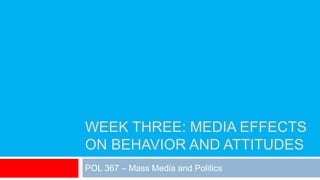
Mass media & politics week 3
- 1. WEEK THREE: MEDIA EFFECTS ON BEHAVIOR AND ATTITUDES POL 367 – Mass Media and Politics
- 2. Agenda Control “May not be successful most of the time in telling people what to think, but it is stunningly successful in telling its readers what to think about.” – Bernard Cohen There are three main ways that media is capable of influencing what people think about: Agenda Setting Priming Framing
- 3. Agenda Setting By giving differential attention to certain issues, media sets the agenda of public discourse. The more attention given to an issue, the more important people perceive it as being important: Institutional: government officials, elites perceive as important Public: affects what citizens think is important Is most potent on issues not already widely discussed and is beyond people’s personal experiences.
- 4. Agenda Setting: Perception of Crime
- 5. Priming Media affects criteria by which political leaders are judged. More prominent an issue, the more it will influence assessment. Cognitive processes: Increases accessibility of knowledge, more likely to use Increases weight of knowledge on decision making Differs from persuasion: Persuasion – changing perception and attitude Priming – changes issues are given weight in decision
- 8. Framing Media can influence opinion about an issue by how they emphasize or de-emphasize different facets of an issue Categories of framing (Iyengar) Equivalency versus Emphasis Different but logically equivalent words to describe same event Highlighting different subsets of potentially relevant considerations Episodic versus Thematic Depicts issues in terms of individual instances or events Places events within larger social, cultural, political context
- 9. Framing: Nelson, Clawson, & Oxley (1997)
- 10. Framing: Neuman, Just, & Crigler (1992) Common Media Frames: Economic Frame – discussion of impact on bottom line, profit, capitalism Conflict Frame – individuals and groups as polarized forces, battle Powerlessness Frame – individuals & groups helpless to larger forces Human Impact Frame – Describing impact on individuals and groups Morality Frame – Indirect references to moral and cultural frame Conflict Frame is the most prevalent in American news media.
- 11. Socialization The transmission of and internalization of a society’s cultural value, ideologies, and beliefs. Sources of socialization: Parents School Groups (ex: groups) Media was often ignored but is now seen as a major source of socialization
- 12. Ex: Attitudes Towards Lesbian and Gay Individuals Jeremiah Garretson: Positive exposure to lesbian & gay individuals in media one mechanism to explain positive attitudes towards homosexuals among youth. Also encouraged more LGBT individuals to “come out”, increasing personal contact.
- 13. Socialization Across Age Groups Children Consumption of media – often media originally intended for adults – dramatically increases as children grow up. Children’s brains are primed for learning, apt to take information at face value. Teenage Teenagers mention media as major source of information. Piaget: complex reasoning skills fully develop during teenage years. Increased skepticism towards authority figures Adulthood Political attitudes are mostly stabilized: learning is mostly supplemental Entertainment is major source of socialization More likely to rely on media in cases where personal experience or social contacts are minimal
- 14. Theories of Media Choice: Use and Gratification Individuals ignore personally irrelevant and unattractive presented messages. Prefer things that are useful and intellectually or emotionally gratifying, given time and effort constraints Three categories of motivations: Curiosity and surveillance Entertainment and escape Social and psychological adjustment
- 15. Theories of Media Choice: Selective Exposure Cognitive balance Avoid information that disturbs peace of mind, offends taste, or conflicts with prior attitudes Partisan selective exposure Motivated selection of pro-attitudinal messages and motivated avoidance of counter-attitudinal messages Social media allows for incidental exposure if networks are diverse. Partisan media usually covers the same stories, difference in the valence, framing, etc.
- 16. Selective Exposure in 2016 Election
- 17. Avoidance of News: Marcus Prior “Conditional Learning” Knowledge dependent on interest in news and politics Gap in knowledge between high and low interest people driven by greater media choice. Easier to avoid news or only choose pro- attitudinal news
- 18. Learning People have developed ideas and feelings about how the world works. These configurations are called schemas or scripts. Help to assimilate new information More knowledgeable individuals have more developed schemas (ex: ideology) and better able to absorb information. However, more knowledgeable individuals usually also hardest to persuade, engage in more motivated reasoning
- 19. News & Personal Experience (Bennet) To reduce information processing, people use a variety of strategies: Cueing – look for cues or labels, such as party id, endorsements, etc. Bolstering – Selecting information to support positions attached to cues Weighing – Using emotions attached to cues to direct attention & learning Personal Organizing – Filter information into central organizing principles
- 20. Factual Learning American factual knowledge on politics is routinely reported as low. Low factual knowledge, however, may not necessarily be a bad thing: Follow up questions usually show greater understanding of issues News stories may leave general impressions and emotions even if specific facts that created those impressions are forgotten (online- processing model)
- 21. Deterrents to Learning Lack of interest in politics Distrust in media Information overload Constant sense of crisis Information presented in disconnected snippets Information presented too short, too fast Little time to process information presented